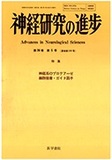Japanese
English
- 有料閲覧
- Abstract 文献概要
- 1ページ目 Look Inside
はじめに
末梢の交感神経は,脊髄に細胞体をおき,その軸索が自律神経節まで伸び,そこでシナプスを形成する節前ニューロンと,自律神経節に細胞体をおき,その軸索を効果器まで伸ばし,効果器とシナプスを形成する節後ニューロンで構成されている。ひとつの節前ニューロンは多くの節後ニューロンと結合している。その結果,多くの末梢器官の働きが同時に,いわゆる“交感的”に制御されることになる。図1に交感神経の節前ニューロンの軸索(実線)と節後ニューロンの軸索(点線)の走行が模式的に描いてある。節前ニューロンの軸索は,その出発する脊髄レベルによって,同レベルの神経節に終るもの,上行していくもの,下行するもの(図には示してない)など,その走行には一定のきまりがある。節後ニューロンの軸索は,運動神経線維などとともに末梢器官まで伸び,効果器(例えば血管)に到達すると,そこで分枝し,密に分布する。しかし,非効果器(骨格筋など)には全く分布しない。本章は,交感神経を節前ニューロンと節後ニューロンに分けて,その軸索の走行と末梢器官の神経支配様式を規定している因子について述べる。自律神経ニューロンの全般的発達とそれに影響を与える因子については,他の総説を参照されたい18,26,37,38)。
Peripheral sympathetic nervous system consists of preganglionic and postganglionic neurons. Pre-ganglionic neurones, whose cell bodies locate in the spinal cord, extend their axons into the sympathetic ganglia and make synapses with postganglionic neurones in the ganglia. The present article describes the specificity of pathway taken by the preganglionic axons and their growth cone behavior in response to other kinds of axons. It also describes factors which affect the guidance of preganglionic axons to the ganglia.
Postganglionic neurones, whose cell bodies locate in the ganglia, extend their axons to effectororgans and innervate effector organs but not noneffector organs. Many experimental evidences show the significant roles of NGF in guiding postganglionic axons to effector organs. However, it remains unclear whether recognition mechanism is involved in the determination of sympathetic innervation patterns of peripheral organs. Sympathetic fibers distribute densely in effector organs, but scarcely in noneffector organs. I examined effects of tissue-derived materials on neuronal adhesivity and behavior of nerve terminals in culture. Sympathetic postganglionic neurones adhered firmly to a dish precoated with expansor secundariorum (effector organ) conditioned medium but not to one precoated with skeletal muscle (noneffector organ) conditioned medium. To isolate molecules which mediate specific connections between sympathetic nerves and effector organs, I developed a simple in vitro assay method detecting the ability of nerve terminals to recognize the specific molecules. By using this method, I found that sympathetic fibers distributed densely on substrates coated with the particulate (adheron) fractions of conditioned medium from expansor secundariorum, but were repelled on substrates coated with those from skeletal muscle. These results suggested that adheron particles were involved in the haptotactic process of specific sympathetic innervation on the effector organs. Enzymatic studies sug-gested that repelling factor from skeletal muscle was heparansulfate proteoglycan. Subcutaneous injec-tion of the antiserum against adheron particles from heart (effector organ) into the chick inhibited the regeneration of adrenergic fibers following 6-hydroxydopamine-induced axotomy in peripheral tissues. The result indicated that adheron particles might function in the process of reinnervation of lesioned sympathetic fibers on effector organs. The factor which causes a dense sympathetic fiber growth was purified from heart conditioned medium. The most purified fraction showed a band with an apparent molecular size of 370 kDa on SDS-PAGE under nonreducing and reducing conditions. The protein was named “sympathonectin”, based on its biological activity. The activiity of sympathonectin was over 100 times higher than that of laminin. Sympathonectin was present outer surface of heart or expansor secundariorum, but not that of skeletal muscle, whereas laminin was present outer surface of these three tissues. Immunoreactivity is also different between sympathonectin and laminin. Thus, sympathonectin is a new extracellular matrix or cell membrane protein which is recognized by sympathetic nerve terminals and mediate sympathetic innervation of effector organs.

Copyright © 1992, Igaku-Shoin Ltd. All rights reserved.


